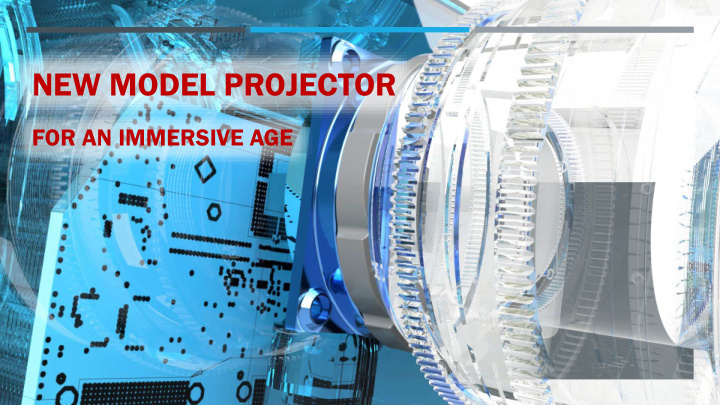



NEW MODEL PROJECTOR FOR AN IMMERSIVE AGE
VINTAGE VIDEO PROJECTORS UGLY PLASTIC BOXES
VIDEO PROJECTORS: HOW DID YOU CHOOSE AND USE? The best resolution and output you could afford ¡ Hopefully one with enough light to work in your space ¡ Bring it home, try to mount it somewhere that wouldn’t be in the way; hope no one will notice the ugly plastic box in ¡ your living room Leave it there until you realize that the image isn’t nearly as bright as in new projectors, and that your television has ¡ much better resolution than your 5-year-old 720P projector Toss the monstrosity ¡
CURRENT VIDEO PROJECTORS Prof ofessio ional $1 $10k O Optio ion High Hi h End Home Home Op Option SAME UGLY PLASTIC BOX Christie Digital @ $10k Price Point Optoma UHD50 @ $1k Price Point ~6,000 Lumens 2,400 Lumens 1080p ->Semi-4k 4K UHD Choice of ~7 Lenses One Lens Big Plastic Boxes Slightly Smaller Plastic Box
… AND PROJECTOR MOUNTS Com ommercial ial DI DIY
CURRENT VIDEO PROJECTORS No standardized mounting system –Mounting is ugly, time-consuming, and inclines consumers to never again move ¡ their projector, even if it means not using it. No choices in lenses for projectors costing <$5,000. Limited choices in even the most expensive units. ¡ No options in Light Engines. You buy a beige, white or black box, and whatever lamp is in it is what you always need ¡ to use. –No ability to upgrade. Projectors are dumb umb . They don’t know where they are, what they’re projecting onto, and cannot be responsive to ¡ things that everyone now assumes that even their phone can track Conventional projectors are really, really hard to implement in emerging opportunities that use light, imagery, real- ¡ time SFX, and responsive architecture
VINTAGE VIDEO CAMERAS
NEW MODEL VIDEO CAMERA
MODULAR PRODUCT
MODULAR ECOSYSTEM: EXPLOITING ADDITIVE AND SUBTRACTIVE MANUFACTURING
NEW MODEL VIDEO PROJECTOR
CONFIGURABLE Buy the components you want to create the projector ¡ you need Built to be used where you need it, and to adapt to that ¡ environment Employs physical and data standards, to ensure it can ¡ connect to whatever you need, in whatever way you need Change it when it needs to change ¡
THIRD-PARTY MODULAR ECOSYSTEM: BOTH CONVENTIONAL + INNOVATIVE LIGHT ENGINES Xenon Arri Orbiter 3x LED System w/o Full Spectrum LED w/ Color Wheel Color Wheel Hive Plasma Lamps Lasers (Full Spectrum + Color Wheel)
THIRD-PARTY MODULAR ECOSYSTEM: MOUNTS AND HOUSINGS Product uctio ion a and I Instal allat atio ion n –Standardized Reside ident ntial al –Standardized Quick Release Quick Release to Design or Production Tools to any Wall or Ceiling Connector
LENS MOUNT OPTIONS (SWAPPED VIA 4 M3 HEX SCREWS) Canon EF. Enabling control of focus and zoom, ¡ as well as real-time metadata transfer, using an extremely broad range of lens options. Cooke /i lens technology, as with Canon, but ¡ with specific applicability to VFX Simple C-type mount, for core installations, also ¡ enabling creation of inexpensive, but fully optimized compound lens designs Bellows lens/lens mount combination, enabling ¡ physical control of keystoning and other undesired (or desired) physical effects
LIGHT ENGINES Light Engines connect via Arri’s Quick Lighting ¡ Mount (QLM) system, or adaptors integrating that locking mechanism The projector’s internal light path is designed to ¡ make effective use of as diverse light sources as possible. This includes: Single Color LEDs, using intermediary color wheel ¡ Multiple Color LEDs, controlled by the projector ¡ Plasma, using intermediary color wheel ¡
COLOR WHEEL Optional QLM-mounted component, between the ¡ housing and continuous full-spectrum light engine
MUCH OF THE CAMERA ECOSYSTEM IS ALSO OUR ECOSYSTEM:
IMAGING (DLP) Designed around the Texas Instruments DLP660TE ¡ 0.66 4K UHD DMD Initial (high-end) cost estimates based on TI’s EVM ¡ boards
BRAINS Data/control to and from lenses is managed via small ¡ onboard processing unit, as is real-time sensor data Because a projector should always know where it stands, ¡ and what it is projecting upon, two sensor types are integrated into the basic design RealSense T265 Tracking Camera, for projector positioning; real- ¡ time integration with computer-generated 3D components. RealSense D435 Depth Camera, for awareness of physical space, ¡ and integration with physical components. The Azure Kinect is an optional add-on, along with a required ¡ modified Magnus EN72070V The Azure Kinect is an optional add-on, along with a ¡ required modified Magnus EN72070V
SHARING DATA The projector begins by tracking its own position, as ¡ well as its environment, as SLAM data It is built specifically to speak with the systems that are ¡ likely to be employed in advanced use of its capabilities, sharing information and control of the physical environment in which the projector is placed: Unreal Engine ¡ Blacktrax, Ncam, Notch, etc ¡ BIM software and other tools of the physical environment ¡
PRICING AND LAUNCH PARTNERSHIPS $5,000 - $10,000, depending on configuration ¡ Working toward launch partnerships with: ¡ Epic (software) ¡ Arri (lights) ¡ Hive (plasma lights) ¡ Worldstage (industry engagement and distribution) ¡ Intel (RealSense) ¡ Nvidia (graphics processing) ¡ Microsoft (software and Azure Kinect) ¡
NEW MODEL PROJECTOR FOR AN IMMERSIVE AGE
Recommend
More recommend